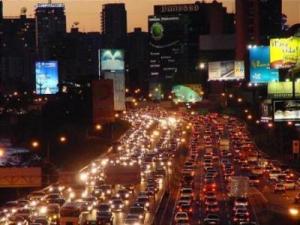"Pico y Placa" Chronicles

Pico y Placa malo – on the left (puro amarillo) vs. Pico y Placa bueno – on the right (rojito, see?)
Just four months before the 8-D local elections, the central government has suddenly discovered there’s total traffic chaos in Caracas and now wants to do something about it.
Ground Transportation Minister Haiman El Troudi made public this week the “Mobility Plan for Caracas”. During his presentation, El-Troudi was open to apply traffic restriction measures, like the “pico y placa” program used in Bogotá, which forces private cars off the road during rush hour for one day each week, according to the number of their license plates.
Sadly for him, the “pico y placa” plan was already declared unconstitutional by the TSJ. According to an old decision of the Constitutional Chamber, such plan violate the “right to free transit” of all citizens.
Back in 2007, the Baruta and Chacao municipalitites (both held by the opposition) decided to implement pico y placa to reduce congestion. The national government strongly opposed this idea and then the courts intervened by suspending it. That ruling didn’t stop the towns of San Antonio del Táchira and Ureña (in the Colombian-Venezuelan border and both held by Chavismo), which started to use pico y placa since early last year.
So let’s review the score: if an opposition mayor or governor want to apply an idea that could help to alleviate some problem, in Act I Chavismo will use all the tools at its disposal to stop it. (And that’s a lot of tools.) Act II is… steal the idea.
Folks, it’s all about electioneering. Need proof? During the presentation of the Mobility Plan, sitting next to Minister El-Troudi was Ernesto Villegas. Why he was there if he’s no longer Information Minister? Because he’s Chavismo’s candidate for Metropolitan Mayor of Caracas, that’s why.
Caracas Chronicles is 100% reader-supported.
We’ve been able to hang on for 22 years in one of the craziest media landscapes in the world. We’ve seen different media outlets in Venezuela (and abroad) closing shop, something we’re looking to avoid at all costs. Your collaboration goes a long way in helping us weather the storm.
Donate




